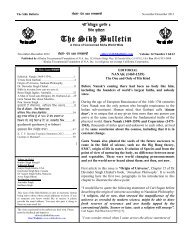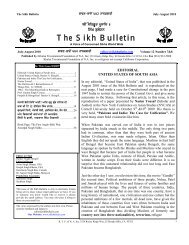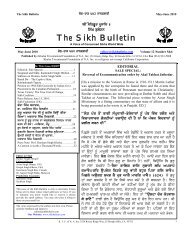Create successful ePaper yourself
Turn your PDF publications into a flip-book with our unique Google optimized e-Paper software.
<strong>The</strong> <strong>Sikh</strong> <strong>Bulletin</strong> vYswK 537 April 2005<br />
jy jIvY piq lQI jwie ] sBu hrwmu jyqw ikCu Kwie ] SGGS, P. 142.<br />
Which has been translated by a learned scholar in his recently<br />
published Ph.D. thesis 3 as:<br />
“a life without dignity is not worth living”. A similar<br />
interpretation of this same stanza was also given by a famous<br />
Ragi during the period of turmoil after the ‘Operation Blue<br />
Star’ in 1984, probably to incite the <strong>Sikh</strong> masses, who were<br />
eager at that time to hear something like that.<br />
Such an interpretation is a blatant twisting of Gurbani to<br />
serve one’s purpose and a total disregard of the context in<br />
which the hymn has been said. <strong>The</strong> first sentence of this<br />
hymn and the one preceding the above sentence is:<br />
so jIivAw ijsu min visAw soie ] nwnk Avru n jIvY koie ]<br />
<strong>The</strong> meaning is quite clear: He alone is really alive, in whose<br />
mind the Lord dwells; says Nanak, no one else is truly living.<br />
To this now if we add the next sentence the correct meaning<br />
comes out: Even if such a person is considered living, his life<br />
is devoid of honor; and whatever he consumes is impure. <strong>The</strong><br />
meaning becomes further clear if one reads on the rest of the<br />
hymn.<br />
Today a substantial number of <strong>Sikh</strong> youth is willing and<br />
eager to learn about their religion and scriptures, but when<br />
they are unable to fulfill this desire, either at home or at the<br />
Gurdwara, they get frustrated. <strong>The</strong>y need to be taught<br />
elements of <strong>Sikh</strong> history and religion (scriptures) in English,<br />
so that they become motivated to learn more. <strong>The</strong>n they will<br />
learn Punjabi and go further into the study of Guru Granth<br />
Sahib.<br />
individual. This would alleviate personal biases<br />
that, more often than not, creep into such<br />
publications. Such a task could be initiated and<br />
monitored by a “<strong>Sikh</strong> Research Council” 4<br />
2. Only Granthis, Ragis and Parcharaks with a certain<br />
level of education and training should be<br />
encouraged to conduct Gurdwara services.<br />
3. A forum should be created where in addition to<br />
interpretation of Gurbani various current social<br />
problems (vegetarianism, use of drugs, divorce<br />
etc.,) are discussed in the light of Gurmat.<br />
1 . Prof. Karen Leonard, U.C.Irvine, Californea; personal communication.<br />
2 . First <strong>Sikh</strong> Renaissance conference, 1995.<br />
3 . G.S.Mann, Ph.D thesis, Columbia University, New York, 1993; P. 43.<br />
4 . Drs. I.J.Singh and Hakam Singh, <strong>The</strong> <strong>Sikh</strong> Review; May 1996, P. 43.<br />
*****<br />
RSS HAD SECRET MEETINGS WITH SIKH<br />
HARDLINERS<br />
New Delhi, March 14, 2005<br />
Before the Akali-BJP combine took power in Punjab in<br />
1998, the RSS began a dialogue with <strong>Sikh</strong> hardliners to<br />
understand their mindset and to checkmate the recurrence of<br />
the turmoil in the state, according to an RSS report. <strong>The</strong><br />
Akali leadership, it says, dissociated itself from <strong>Sikh</strong><br />
militants, but the RSS acted aggressively on a "long-term<br />
perspective", before and during the Akali-BJP rule in<br />
Punjab to woo the community hurt by more than a decade of<br />
unrest. A documented RSS report talks of the sangh’s<br />
moves at understanding the <strong>Sikh</strong> psyche and ideas that led<br />
to the demand for “Khalistan”.<br />
It is extremely important that at the early stages of their<br />
education caution is exercised to explain their day-to-day<br />
questions strictly according to the teachings of Guru Granth<br />
Sahib without commingling our own idiosyncrasies or biases.<br />
Unfortunately, the currently available English translations of<br />
Gurbani are by the people of the last generation. <strong>The</strong>y have<br />
used Shakespearian language and semi – poetical format.<br />
This imposes space limits and makes it difficult to fully<br />
explain the concept or the central theme of a hymn. This<br />
makes it doubly difficult for the youth, who have learned<br />
modern English, to fully grasp the meaning.<br />
A very important task before those who have and urge to help<br />
our young people and can afford to do so is to have at least<br />
the more pertinent Gurbanis translated at a level that is<br />
intelligible to the young <strong>Sikh</strong>s. This would be the first<br />
significant step towards initiating them to the <strong>Sikh</strong> scriptures.<br />
Some other steps that need to be taken immediately in order<br />
to stop our youth from going astray are given below:<br />
1. History books and Gurbani translations, in simple<br />
English prose, should be provided. <strong>The</strong>se should be<br />
prepared by a panel of scholars rather than by an<br />
<strong>The</strong> Sangh Parivar first held a meeting with those who<br />
mattered a great deal in Damdami Taksal of Sant Jarnail<br />
Singh Bhinderanwale in 1998, the report said. RSS chief<br />
Sudarshan had voiced reservations at the meeting over some<br />
“provocative” pictures in the taksal’s yearly diary in 1998.<br />
<strong>The</strong> documents, however, describe the meeting as a<br />
successful beginning of the RSS dialogue with the <strong>Sikh</strong><br />
militants as the taksal leaders not only agreed to withdraw<br />
the diary, but also agreed to hold regular interaction with the<br />
RSS chief.<br />
<strong>The</strong> RSS initiative was taken by Mr Rulda Singh, founder<br />
and member of the Shiromani Samiti of the Rashtriya <strong>Sikh</strong><br />
Sangat. He claims to have received religious education<br />
from Damdami Taksal when Sant Kartar Singh was its chief<br />
and Sant Bhinderanwale was one of its students. <strong>The</strong><br />
meetings, denied by taksal leaders stoutly, were, however,<br />
secret at that time. Even now when contacted, the taksal<br />
dubbed RSS documents an attempt to “bring discredit to the<br />
seat headed once by <strong>Sikh</strong> martyr Baba Deep Singh of the<br />
18th century”.<br />
With Mr Rulda Singh in the forefront, the documents say,<br />
the RSS leaders held a series of meetings with Sant Samaj<br />
<strong>The</strong> <strong>Sikh</strong> Center Roseville, 201 Berkeley Ave, Roseville, CA. 95678 18
















